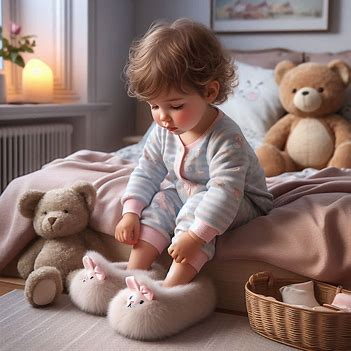Tips on How to Dress Toddler for Sleep
As a parent, getting your toddler to sleep can feel like a never-ending challenge. One often overlooked aspect is how we dress our little ones for bedtime. The right sleepwear can make all the difference between a restless night and peaceful slumber. Let’s dive into some practical tips to ensure your toddler is comfy and cozy all night long.
Quick Answer: Dress your toddler in breathable, comfortable layers appropriate for the room temperature, typically starting with a base layer like a onesie, adding pajamas, and using a sleep sack if needed. Avoid overdressing and prioritize safety by choosing well-fitting sleepwear.
Understanding Your Toddler’s Sleep Needs
Before we jump into the nitty-gritty of sleepwear, it’s crucial to understand that every toddler is unique. What works for one child might not work for another. Factors like age, activity level, and personal preferences all play a role in determining the best sleep outfit for your little one.
Age Matters
Younger toddlers (1-2 years) might still benefit from the coziness of a sleep sack, while older toddlers (2-3 years) might prefer more freedom to move around in traditional pajamas. It’s all about finding that sweet spot between comfort and practicality.
Activity Level
Is your toddler a little tornado, always on the move? Or more of a cuddle bug? Active kiddos tend to run warmer and might need lighter sleepwear to prevent overheating. On the flip side, less active toddlers might need an extra layer to stay cozy through the night.
Choosing the Right Sleepwear
Now that we’ve covered the basics, let’s talk about picking out the perfect pajamas for your toddler.
Fabric Matters
When it comes to sleepwear, not all fabrics are created equal. Here’s a quick rundown of some popular options:
- Cotton: A classic choice, cotton is breathable and perfect for sensitive skin. It’s ideal for warmer nights or toddlers who tend to overheat.
- Fleece: Super cozy and warm, fleece is great for chilly nights. Just be careful not to overdo it, as it can sometimes lead to overheating.
- Bamboo: This eco-friendly option is softer than cotton and naturally moisture-wicking. It’s a great choice for toddlers with sensitive skin or allergies.
Finding the Right Fit
When it comes to toddler sleepwear, fit is key. You want something snug enough to be safe (loose clothing can be a hazard), but not so tight that it restricts movement or comfort. Look for pajamas that fit well around the neck, wrists, and ankles without any loose or dangly bits.
Dressing for the Seasons
Just like us grown-ups, toddlers need different sleepwear for different seasons. Here’s a handy guide:
| Season | Recommended Sleepwear |
|---|---|
| Spring | Lightweight long-sleeve pajamas or a short-sleeve top with long pants |
| Summer | Short-sleeve and short-leg pajamas or just a onesie |
| Fall | Long-sleeve and long-leg pajamas, maybe with socks |
| Winter | Fleece pajamas or layered cotton pajamas with a sleep sack |
The Art of Layering
Layering is a parent’s secret weapon when it comes to dressing toddlers for sleep. It allows you to easily adjust your child’s temperature throughout the night without causing too much disruption.
Base Layer
Start with a thin, breathable layer next to your toddler’s skin. This could be a onesie or a light t-shirt. The key is to choose something comfortable that won’t bunch up or irritate their skin.
Middle Layer
This is where your main pajamas come in. Depending on the season and your home’s temperature, this could be a long-sleeve and long-pant set, or something lighter for warmer nights.
Outer Layer
For cooler nights, you might want to add an outer layer like a sleep sack or wearable blanket. These are safer alternatives to loose blankets, which can pose a suffocation risk for younger toddlers.
Personal Experience: The Sleep Sack Revelation
I remember when my son, Tommy, was about 18 months old. We were having a terrible time with night wakings, and I couldn’t figure out why. He’d start the night off fine, but by 2 AM, he’d be crying and unable to settle back down.
After a week of sleepless nights, I had a lightbulb moment. I realized that Tommy was kicking off his blankets in his sleep and waking up cold. We switched to a sleep sack, and it was like magic! He stayed cozy all night long, and we all started getting better sleep. Sometimes, the simplest solutions make the biggest difference!
Safety First: Things to Avoid
When dressing your toddler for sleep, there are a few key things to steer clear of:
- Drawstrings or loose ties: These can be a strangulation hazard.
- Overly loose clothing: Baggy sleepwear can ride up over your toddler’s face.
- Non-flame resistant fabrics: Look for sleepwear labeled as flame resistant for added safety.
The Temperature Game: Getting It Just Right
One of the trickiest parts of dressing a toddler for sleep is getting the temperature right. Too hot, and they’ll be sweaty and uncomfortable. Too cold, and they’ll wake up crying. Here are some tips to help you nail it:
Check the Room Temperature
Aim to keep your toddler’s room between 68-72°F (20-22°C). This is the sweet spot for comfortable sleep. If you’re not sure, invest in a simple room thermometer.
The Touch Test
Feel your toddler’s chest or back. If it’s sweaty or hot to the touch, they’re too warm. If it feels cool, they might need an extra layer. The goal is for their skin to feel comfortably warm, not hot or cold.
Watch for Signs
Your toddler will often let you know if they’re uncomfortable. Sweating, restlessness, or waking up frequently can all be signs that they’re too warm. If they’re curling up into a tight ball, they might be cold.
Special Considerations
Potty Training
If your toddler is in the midst of potty training, you’ll want to consider sleepwear that’s easy to remove quickly. Two-piece pajamas or nightgowns can be great options.
Sensitive Skin
For toddlers with eczema or sensitive skin, opt for soft, natural fibers like cotton or bamboo. Avoid scratchy tags or seams that might irritate their skin.
Night Sweats
Some toddlers are prone to night sweats. If this is the case for your little one, moisture-wicking fabrics can help keep them comfortable and dry throughout the night.
Making Bedtime Fun
Getting dressed for bed doesn’t have to be a chore. Here are some ways to make it an enjoyable part of your toddler’s bedtime routine:
- Let them choose: Give your toddler a choice between two appropriate options. This can help them feel more in control and excited about bedtime.
- Make it a game: See who can get their pajamas on fastest, or play “Simon Says” with each piece of clothing.
- Read bedtime stories: Choose books about getting ready for bed to reinforce the routine.
Wrapping It Up: Your Toddler Sleep Dress Code
Dressing your toddler for sleep might seem like a small detail in the grand scheme of parenting, but it can have a big impact on the quality of your little one’s rest. Remember, every child is different, so don’t be afraid to experiment a bit to find what works best for your toddler.
The key takeaways? Choose comfortable, breathable fabrics. Layer wisely based on the room temperature and season. Prioritize safety by avoiding loose clothing or blankets. And most importantly, pay attention to your toddler’s cues. They’ll let you know if something’s not quite right.
With these tips in mind, you’re well on your way to mastering the art of dressing your toddler for sleep. Sweet dreams to you and your little one!

Jessica Winter is a passionate parenting blogger with two years of experience guiding new and seasoned parents through the joys and challenges of raising babies. Her insightful posts blend personal anecdotes with expert advice to offer a warm and practical perspective on modern parenting.

